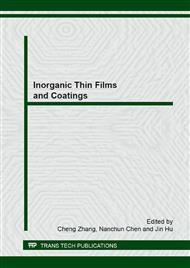[1]
Güntherschlze and H. Betz. Die Electronenstromung in Isolatoren bei Extremen Feldstarken, Z.Phys. 91(1934)70.
Google Scholar
[2]
Q. B. Nguyen, M.Gupta, Enhancing compressive response of AZ31B using nano-Al2O3 and copper additions, Journal of Alloys and Compounds, 490 (2010) 382.
DOI: 10.1016/j.jallcom.2009.09.188
Google Scholar
[3]
S. V. Gnednekov, O. A. Khrisanfova, A. G. Zavidnaya, Composition and adhesion of protective coatings on aluminum, Surf. Coat. Technol. 145 (2001) 146.
DOI: 10.1016/s0257-8972(01)01307-x
Google Scholar
[4]
A.A. Voevodin, A.L. Yerokhin, V.V. Lyubinov, et al., Characterization of wear protective Al-Si-O coatings formed on Ai-based alloy by micro-arc discharge treatment, Surf. Coat. Technol. 86-87 (1996) 516.
DOI: 10.1016/s0257-8972(96)03069-1
Google Scholar
[5]
V. S. Rudnev, T. P. Yarovaya, D. L. Boguta, L. M. Tyrina, P. M. Nedozorov, P. S. Gordienko, Anodic spark deposition of P, Me(II) or Me(III) containing coatings on aluminium and titanium alloys in electrolytes with polyphosphate complexes, J. Electroanal. Chem. 497 (2001) 150.
DOI: 10.1016/s0022-0728(00)00483-6
Google Scholar
[6]
B. Rajasekaran, S.G.S. Raman, S.V. Joshi, et al., Effect of microarc oxidised layer thickness on plain fatigue and fretting fatigue behavior of Al–Mg–Si alloy, Int. J. Fatigue, 30 (2008) 1259.
DOI: 10.1016/j.ijfatigue.2007.08.014
Google Scholar
[7]
F. Liu, J.L. Xu, D.Z. Yu, et al., Effects of cathodic voltages on the structure and properties of ceramic coatings formed on NiTi alloy by micro-arc oxidation, Mater. Chem. Phys., 121 (2010) 172.
DOI: 10.1016/j.matchemphys.2010.01.002
Google Scholar
[8]
J. M. Li, H. Cai, B.L. Jiang, Growth mechanism of black ceramic layers formed by microarc oxidation, Surf. Coat. Technol. 201 (2007) 8702.
DOI: 10.1016/j.surfcoat.2007.06.010
Google Scholar
[9]
J. Liang , L.T. Hua, J.C. Hao, Improvement of corrosion properties of microarc oxidation coating on magnesium alloy by optimizing current density parameters, Appl. Surf. Sci. 253 (2007) 6939.
DOI: 10.1016/j.apsusc.2007.02.010
Google Scholar
[10]
S.G. Xin, L.X. Song, R.G. Zhao, X.F.Hu, Properties of aluminum oxide coating on aluminum alloy produced by micro-arc oxidation, Surf. Coat. Technol. 199 (2-3) (2005) 184.
Google Scholar
[11]
V. Raj, M. M. Ali, Formation of ceramic alumina nanocomposite coatings on aluminium for enhanced corrosion resistance, Journal of Materials Processing Technology, 209 (2009) 5341.
DOI: 10.1016/j.jmatprotec.2009.04.004
Google Scholar
[12]
A.L. Yerokhin, X.Nie, A.Leyland, A.Matthews, S. J. Dowey, Plasma Electrolysis for Surface Engineering. Surf. Coat. Technol. 122(1999)73.
DOI: 10.1016/s0257-8972(99)00441-7
Google Scholar


